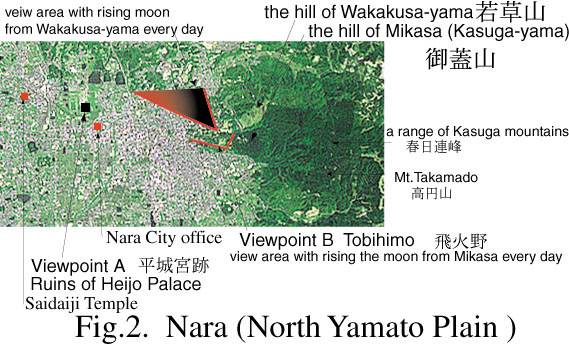
This is a well-known poem of Hyakunin Issyu
ama no hara
furisake mireba
kasuga naru
mikasa no yama ni
ideshi tsuki kamo
When I gaze far out
across the plain of heaven,
I see the same moon
that came up over the hill
of Mikasa at Kasuga.
(Translated by Helen Craig McCullough)
On the other hand, Tosa Nikki (Tosa Diary, Tosa Journal)
aounahara
furisake mireba
kasuga naru
mikasa no yama ni
ideshi tsuki kamo
When I gaze far out
across the blue-green sea plain,
I see the same moon
that came up over the hill
of Mikasa at Kasuga.
(Translated by Helen Craig McCullough)
This poem is said to have been composed, when Nakamaro noticed that the moon had risen at Mingzhou in China. The subject of the poem is said to put in mind of his native-place for Nara.
But there are several doubts to interpretation that Nakamaro composed this poem at Mingzhou to put in mind of his native-place.

First in general, it is impossible to interpret that he had always seen to rise the moon from the hill of Mikasa in Nara (North Yamato Plain). Because the moon does not rise from the hill of Mikasa at the view with Ruins of Heijo Palace, evidently it rise from a range of Kasuga mountains or Mt.Takamado. It is not make a observation to rise the moon from the hill of Mikasa a wide range in Nara.
At all strangely, there are two hills called on Mikasa. One is Mikasa-yama revered at the hill of Higher Power as home of spirits, another is Mikasa-yama (present name of Wakakusa-yama) in the form of three pyramids.
In addition, what is the hill of Mikasa at Kasuga? The word of "Kasuga" has in a suggestion of "the sky is always clouding over as in the spring season". But two hills is too low and their top seldom covered with clouds. Thus it is no reason that the word of "Kasuga" is addition to this poem. (It is Mikasa-yama which is 293 meters high, Wakakusa-yama which is 342 meters high, and Ruins of Heijo Palace which is 65 meters high above sea level.)
Third,It changed the prepositon word "Wo(from)" to "Ni(to)" from two most oldest hand written coppies to many popular books. None of moon rise from the hill of Mikasa with "Wo(from)" in Nara. Because of it,it changed the word "Ni(to)." Its fact showed two old hand written copies.


 Where
was he made in this poem ? I make a suggestion that he made up
poem a verse in Kyushu where Nakamaro had got away from Wa. As
there are two mountains of Mikasa at Tikushi in Kyushu, one is
Mt.Mikasa of Shika island, another is Mt.Houman-zan which used
to be called Mt.Mikasa. Accordingly this Mt.Mikasa(Houman-zan),
which is 829.6 meters high near the seaside, is always clouding
over. Moreover, it is a place name that used to be called Mikasa
river, old village of Mikasa, and old village of Kasuga. It is
possible to interpretation that he had always seen to rise the
moon from the mountain of Mikasa around Dazaifu. I think that
this poem made up poem a verse on board out of Amanohara of Iki
island. There is no alternative it.
Where
was he made in this poem ? I make a suggestion that he made up
poem a verse in Kyushu where Nakamaro had got away from Wa. As
there are two mountains of Mikasa at Tikushi in Kyushu, one is
Mt.Mikasa of Shika island, another is Mt.Houman-zan which used
to be called Mt.Mikasa. Accordingly this Mt.Mikasa(Houman-zan),
which is 829.6 meters high near the seaside, is always clouding
over. Moreover, it is a place name that used to be called Mikasa
river, old village of Mikasa, and old village of Kasuga. It is
possible to interpretation that he had always seen to rise the
moon from the mountain of Mikasa around Dazaifu. I think that
this poem made up poem a verse on board out of Amanohara of Iki
island. There is no alternative it.